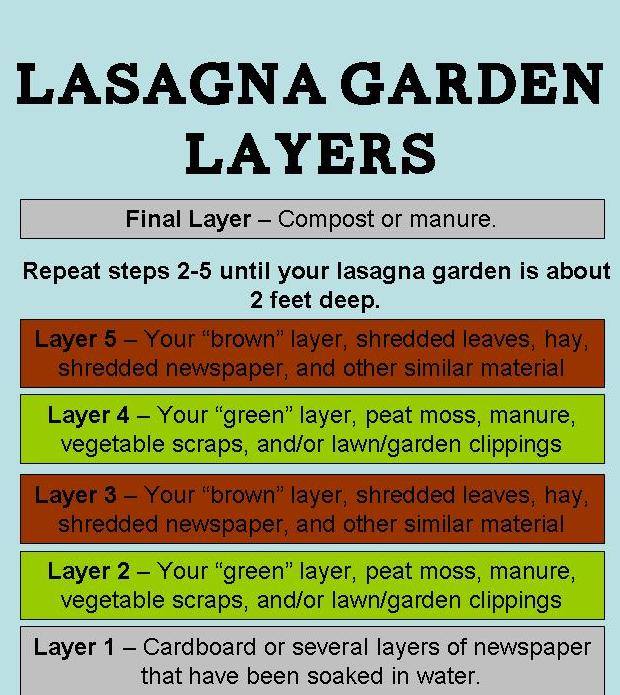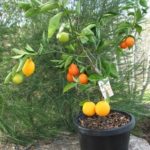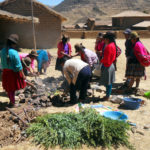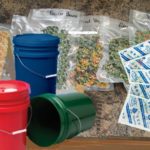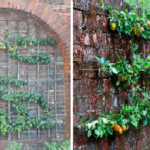Lasagna Gardening
Lasagna Gardening is a no-dig, no-till organic gardening method that will give you rich soil that requires little work from the gardener. The name “Lasagna Gardening” is actually the method of building the garden. You add layers of organic materials that “decompose” over time, and results in soil that will help your plants thrive. It’s definitely great for the environment, because you use your yard and kitchen waste, and then compost it to make a new garden. (Great Heirloom Seed Package listed below to go along with this)
NO DIGGING REQUIRED
One of the best things about Lasagna Gardening is how easy it is. You don’t have to remove existing sod and weeds. You don’t have to double dig. In fact, you don’t have to work the soil at all. The first layer of your Lasagna Garden consists of either brown corrugated cardboard or three layers of newspaper laid directly on top of the grass or weeds in the area you’ve selected for your garden. Wet this layer down to keep everything in place and start the decomposition process. The grass or weeds will break down fairly quickly because they will be smothered by the newspaper or cardboard, as well as by the materials you’re going to layer on top of them. This layer also provides a dark, moist area to attract earthworms that will loosen up the soil as they tunnel through it.
WHAT TO PUT IN YOUR LASAGNA GARDEN
Anything you’d put in a compost pile; you can put into a Lasagna Garden. The materials you put into the garden will break down, providing nutrient-rich, crumbly soil in which to plant. The following materials are all perfect for Lasagna Gardens:
Grass Clippings
Leaves
Fruit and Vegetable Scraps
Coffee Grounds
Tea leaves/ tea bags
Weeds
Manure
Compost
Hay
Shredded newspaper or mail
Pine needles
Trimmings from the garden
You’ll want to alternate layers of “BROWNS” such as fall leaves, shredded newspaper, peat, and pine needles with layers of “GREENS” such as vegetable scraps, garden trimmings, and grass clippings. In general, you want your “brown” layers to be about twice as deep as your “green” layers. What you want at the end of your layering process is a two-foot tall, layered bed. You’ll be amazed at how much this will shrink down in a few short weeks.
WHEN TO MAKE YOUR LASAGNA GARDEN
You can make a Lasagna Garden at any time of year. Fall is a great time for many gardeners because of the amount of organic material you can get for free, with all your fallen leaves and yard waste. You can let your Lasagna Garden sit and break down all winter. By spring, it will be ready to plant in with a minimum of effort. Also, fall rains and winter snow will keep the materials in your Lasagna Garden moist, which will help them break down faster.
If you choose to make a Lasagna Garden in spring or summer, you will need to consider adding more “soil-like” amendments to the bed, such as peat or topsoil, so that you can plant in the garden right away. If you make the bed in Spring, layer as many greens and browns as you can, with layers of finished compost, peat, or topsoil interspersed in them. Finish off the entire bed with three or four inches of finished compost or topsoil, and plant. The bed will settle some over the season as the layers underneath decompose.
PLANTING IN AND MAINTAINING IT
When it’s time to plant, just dig down into the bed as you would with any other garden. If you used newspaper as your bottom layer, the shovel will most likely go right through, exposing nice, loose soil underneath. If you used cardboard, you may have to cut a hole in it at each spot where you want to plant something.
To maintain the garden, simply add mulch to the top of the bed in the form of straw, grass clippings, or chopped leaves. Once it’s established, you will care for a lasagna garden just as you would any other.
ADVANTAGES OF YOUR LASAGNA GARDEN
While you will be maintaining a Lasagna Garden the same way you would care for any other garden, you will find that caring for a Lasagna Garden is less work-intensive. You can expect:
FEW WEEDS…..thanks to the newspaper suppressing them from below and the mulch covering the soil from above.
BETTER WATER RETENTION…..due to the fact that compost (which is what you made by layering all of those materials) holds water better than regular garden soil, especially if your native soil is sandy or deficient in organic matter.
LESS NEED TO HAVE TO FERTILIZE….. because you planted your garden in almost pure compost, which is very nutrient-rich.
SOIL EASY TO WORK…..crumbly, loose, and fluffy.
Lasagna Gardening is fun, easy, and allows you to make a new Garden at a much faster rate than the old double-digging method. Now, your only problem will be finding HEIRLOOMS SEEDS to fill your new garden!
Now for planting your heirloom garden see The Seed Guy at the link below
The Seed Guy
Source Danny Look
 This is an aggregated site. Please be aware some of the sites we link to could have pop ups. We have no control over them. However, we will never link you to a site that requires you to make any purchase to view the blog.
This is an aggregated site. Please be aware some of the sites we link to could have pop ups. We have no control over them. However, we will never link you to a site that requires you to make any purchase to view the blog.
Please read our disclaimer. We provide you with information from various sites all over the world. The author’s expressed opinion isn’t necessarily that of The Prepared Page or its staff. Our intent is to bring you the information. Use your and your own best judgment when using any information contained within the blogs.
While you’re here check out some of the other posts you may find them interesting!!!
Some posts may contain affiliate links.

